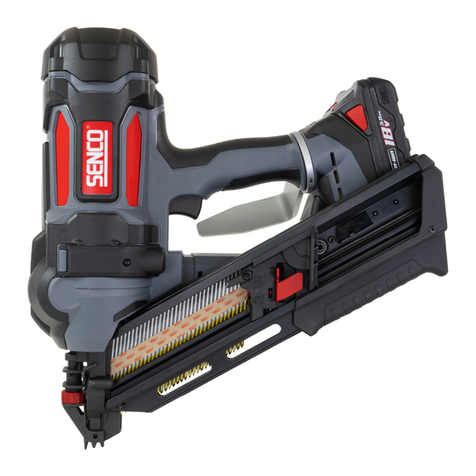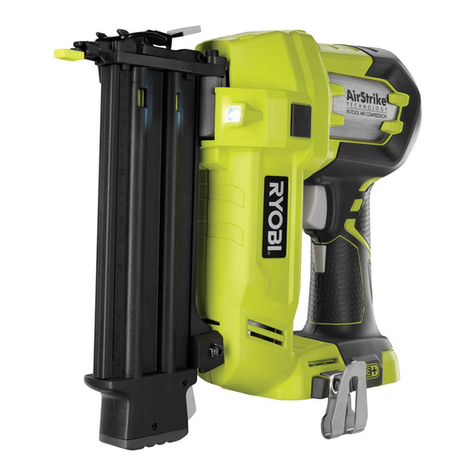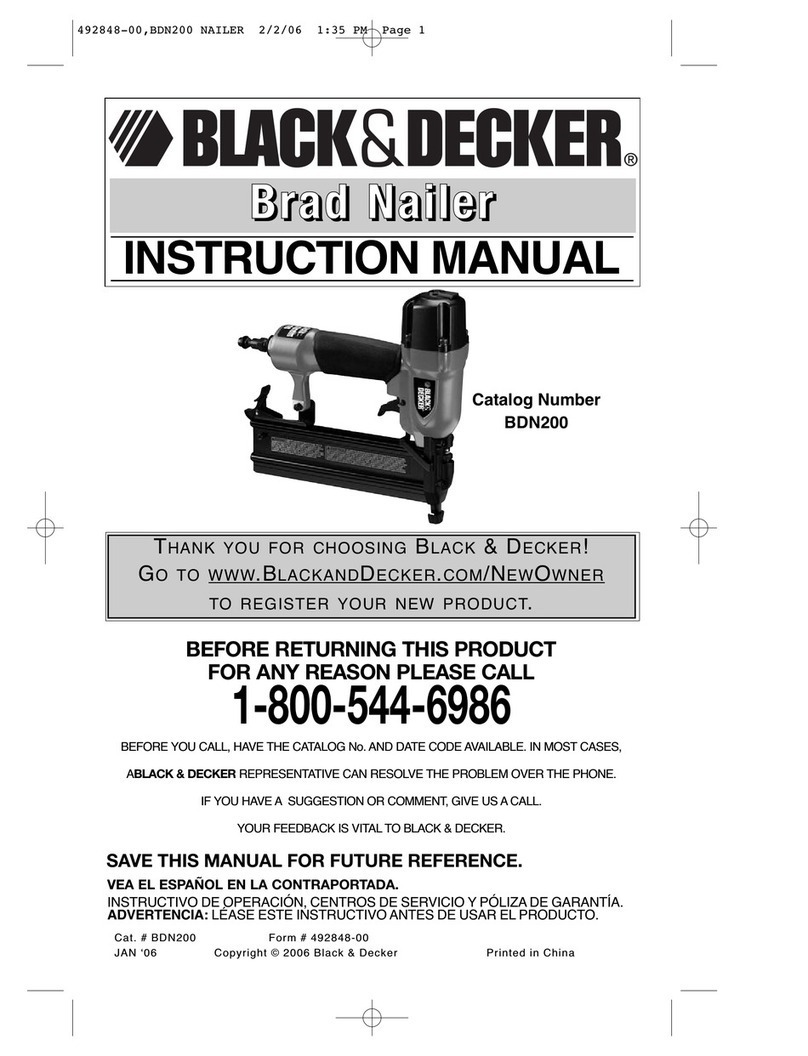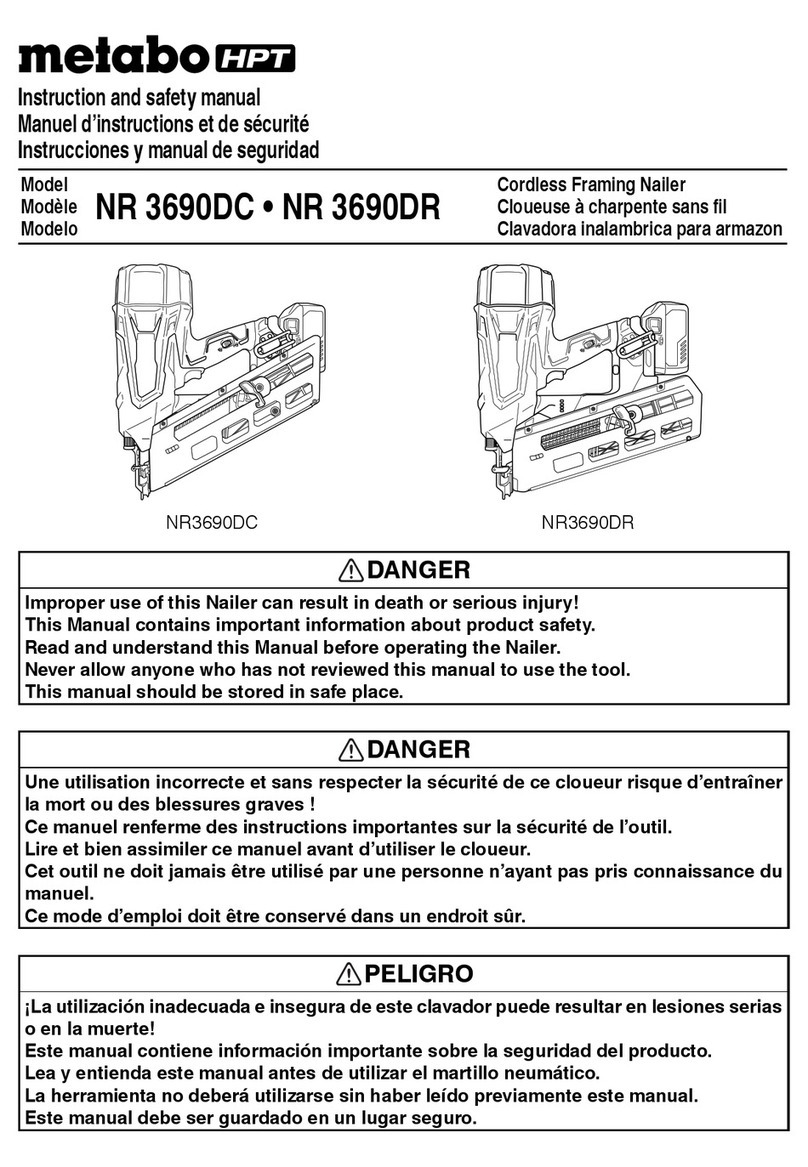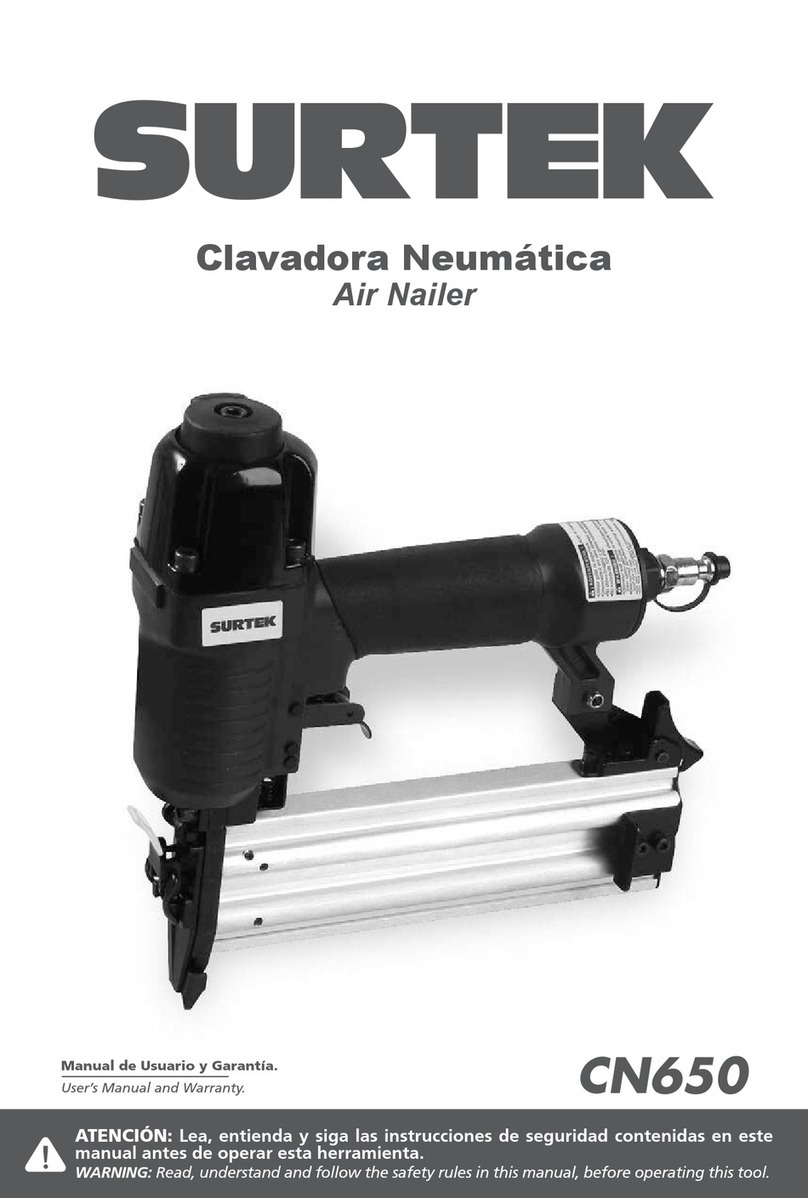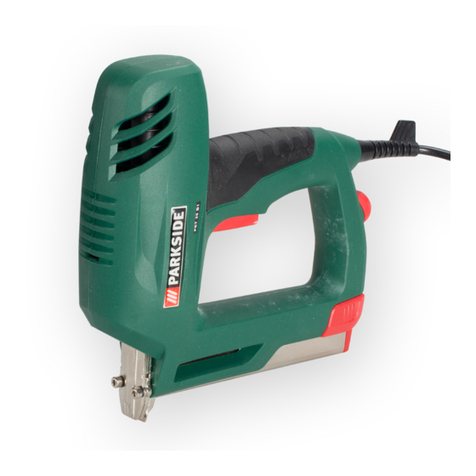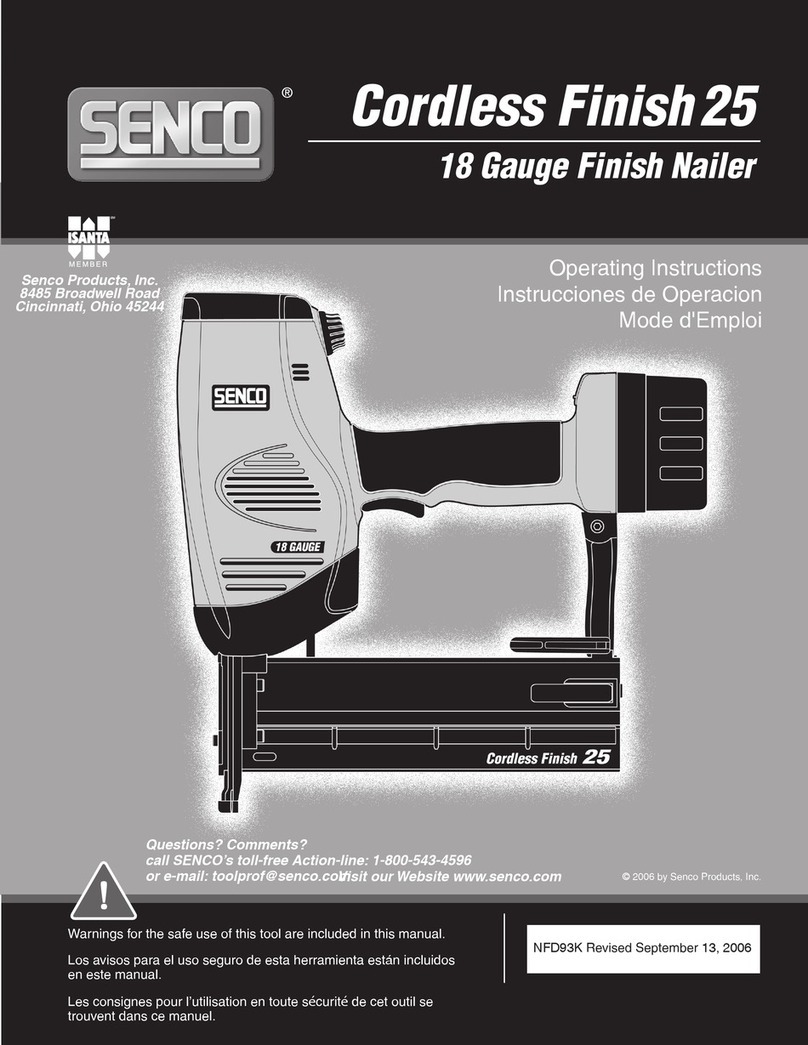North American Tool Industries 7564 Operating instructions

8807564 12/12
21° 3-1/2 INCH FULL ROUND HEAD
FRAMING NAILER
CALIFORNIA PROPOSITION 65
WARNING: You can create dust
when you cut, sand, drill or grind
materials such as wood, paint,
metal, concrete, cement, or other
masonry. This dust often
contains chemicals known to
cause cancer, birth defects, or
other reproductive harm. Wear
protective gear.
WARNING: This product or its
power cord may contain
chemicals, including lead,
known to the State of California
to cause cancer and birth
defects or other reproductive
harm. Wash hands after
handling.
Important!
When using equipment, a few
safety precautions must be
observed to avoid injuries and
damage. Please read the complete
operating manual with due care.
Keep this manual in a safe place,
so that the information is available
at all times. If you give the
equipment to any other person,
give them these operating
instructions as well. We accept no
liability for damage or
accidents which arise due to
non-observance of these
instructions and the safety
information herein.
SPECIFICATIONS
Normal Operating Pressure:
75 PSI - 120 PSI
Firing Mode: Sequential Fire/
Bounce Fire
Fastener Size Range:
2 inches to 3-1/2 inches
Capacity: 55 pieces
FEATURES
•Comfortable rubber grip
•Lightweight magnesium
housing
• Adjustable depth of
penetration
• Anti-dry firing mechanism
• Single sequential, full
sequential, and bounce action
are exchangeable.
• No-Mar Tip protects work
surface.
Keep this manual and
receipt in a safe and dry
place for future reference.
CAUTION:
FOR YOUR OWN SAFETY
READ INSTRUCTION
MANUAL COMPLETELY
AND CAREFULLY BEFORE
OPERATING THIS 3-1/2
INCH CLIPPED HEAD
FRAMING NAILER.
Any failures made in
following the safety
regulations and
instructions may result in
an electric shock, fire
and/or serious injury.
EXPLANATION OF
NAILING ACTION
• SINGLE ACTUATION
MECHANISM: First, press the
safety against the wood.
Next, pull the trigger to drive
the fastener. After fastening
once, fastening will not be
possible again until the trigger
is released and pressed
again.
Model: 7564
For Customer Service, please call 1-800-348-5004 or email feedback@natitools.com

2
• BOUNCE ACTUATION
MECHANISM: First, pull the
trigger. Next, press the safety
against the wood to drive the
fastener. If the trigger is held
back, a fastener will be driven
each time the safety is pressed
against the wood.
• FULL SEQUENTIAL
ACTUATION MECHANISM:
First, press the safety against the
wood. Next, pull the trigger to
drive the fastener. Follow the
same sequence to continue
driving fasteners.
GENERAL SAFETY
RULES
WORK AREA
• KEEP THE WORK AREA
CLEAN AND WELL LIT.
Cluttered benches and dark
areas increases the risk of injury.
• DO NOT OPERATE THE
TOOL IN EXPLOSIVE
ATMOSPHERES, such as in the
presence of flammable liquids,
gases, or dust. The tool may
create a spark that could ignite
flammable liquids, gases, or
dust.
• KEEP VISITORS AWAY. Do
not let visitors handle the tool. All
visitors should be kept safely
away from the work area.
• NEVER ENGAGE IN
HORSEPLAY WITH THE TOOL.
Respect the tool as a working
implement.
PERSONAL SAFETY
• OPERATORS AND OTHERS
IN WORK AREA MUST WEAR
SAFETY GLASSES WITH SIDE
SHIELDS. Safety glasses must
conform to ANSI Z87.1
specifications.
• ALWAYS WEAR EAR AND
HEAD PROTECTION. Wear ear
protection to protect your ears
from loud noises. Wear head
protection to protect your head
from flying objects.
• USE SAFETY EQUIPMENT. A
dust mask, non-skid safety
shoes, and a hard hat must be
used for the applicable
conditions. Wear a full face
shield if you are producing metal
filings or wood chips.
• DRESS PROPERLY. Do not
wear loose clothing or jewelry.
Contain long hair. Keep hair,
clothing, and gloves away from
moving parts. Loose clothes,
jewelry, or long hair can be
caught in moving parts and
increase the risk of injury.
• STAY ALERT, WATCH WHAT
YOU ARE DOING AND USE
COMMON SENSE WHEN
OPERATING A POWER TOOL.
Do not use tool while tired or
under the influence of drugs,
alcohol, or medication. A
moment of inattention while
operating the tool may cause
serious injury.
• AVOID UNINTENTIONAL
FIRING. Keep fingers away from
trigger when not driving
fasteners, especially when
connecting the tool to the air
supply.
• DO NOT OVERREACH. Keep
proper footing and balance at all
times. Proper footing and balance
enables better control of the tool
in unexpected situations.
• MAKE SURE AIR HOSE IS
FREE OF SNAGS AND
OBSTRUCTIONS. DO NOT
ATTACH AN AIR HOSE OR
TOOL TO YOUR BODY.
Entangled or snarled hoses can
cause a loss of balance or footing
in addition to unintentional tool
operation.
TOOL USE AND CARE
• NEVER POINT THE TOOL AT
YOURSELF OR OTHERS IN THE
WORK AREA. Always assume
the tool contains fasteners. Never
point the tool at yourself or others,
whether it contains fasteners or
not.
• KEEP FINGERS AWAY FROM
TRIGGER WHEN NOT DRIVING
FASTENERS TO AVOID
ACCIDENTAL FIRING. Never
carry the tool with the trigger
depressed, since you could
unintentionally drive a fastener
and injure yourself or someone
else. Always carry the tool by the
handle.
• NEVER MODIFY OR ALTER
THE TOOL. Doing so may cause
the tool to malfunction and
personal injuries may result.
• KNOW THIS TOOL. Read this
manual carefully. Learn its
applications and limitations, as
well as the specific potential
hazards related to this tool.
• USE ONLY FASTENERS THAT
ARE RECOMMENDED FOR
YOUR MODEL. Do not use the

3
wrong fasteners or load the
fasteners incorrectly.
• CHECK FOR
MISALIGNMENT OR BINDING
OF MOVING PARTS,
BREAKAGE OF PARTS, OR
ANY OTHER CONDITION
THAT MAY AFFECT THE
TOOL’S OPERATION. If
damaged, have the tool
serviced by an authorized
technician before using. Many
accidents are caused by poorly
maintained tools.
• CHECK SAFETY BEFORE
USE. Make sure the safety
operates properly. Never use
the tool if the safety is not
operating properly. Do not
tamper with or remove the
safety.
• DO NOT USE THE TOOL IF
THE TRIGGER DOES NOT
ACTUATE PROPERLY. Any
tool that cannot be controlled
with the trigger is dangerous
and must be repaired.
• NEVER USE A TOOL THAT
IS DEFECTIVE OR
OPERATING ABNORMALLY. If
the tool appears to be operating
unusually, making strange
noises, or otherwise appears
defective, stop using it
immediately and arrange for
repairs by an authorized service
center.
• MAINTAIN TOOLS WITH
CARE. Keep the tool clean and
lubricated for better and safer
performance.
• NEVER CARRY THE TOOL
BY THE AIR HOSE.
• STORE TOOLS OUT OF THE
REACH OF CHILDREN AND
UNTRAINED PEOPLE. Tools
are dangerous in the hands of
untrained users.
• PLACE TOOL PROPERLY ON
THE WORK PIECE. Do not drive
fasteners on top of other
fasteners or with the tool at too
steep of an angle. The fasteners
can ricochet and cause serious
injury.
• DO NOT USE TOOL AS A
HAMMER.
• KEEP ALL SCREWS AND
COVERS TIGHTLY IN PLACE.
• KEEP FACE, HANDS, AND
FEET AWAY FROM FIRING
HEAD AT ALL TIMES.
• DO NOT DISCONNECT AIR
HOSE FROM TOOL WITH
YOUR FINGER ON THE
TRIGGER. The tool can fire
when reconnected to an air
supply.
• DO NOT LOAD FASTENERS
WITH TRIGGER PULLED OR
SAFETY DEPRESSED.
• NEVER PLACE A HAND OR
ANY PART OF THE BODY IN
FASTENER DISCHARGE AREA
OF TOOL.
• DO NOT DRIVE FASTENERS
INTO THIN BOARDS OR NEAR
EDGES OF WORK PIECE.
• DISCONNECT AIR HOSE
FROM TOOL WHEN:
1. Doing maintenance and
inspection
2. Loading fasteners
3. Turning the adjuster and top
cover
4. Clearing a jam
5. It is not in use
6. Leaving the work area
7. Moving it to another location
8. Handing it to another person
NOTE: Never attempt to clear a
jam or repair the tool unless you
have disconnected the air hose
from the tool and removed all
remaining fasteners from the tool.
TOOL SERVICE
• USE ONLY ACCESSORIES
THAT ARE IDENTIFIED BY THE
MANUFACTURER FOR THE
SPECIFIC TOOL MODEL.
• USE OF UNAUTHORIZED
PARTS OR FAILURE TO
FOLLOW MAINTENANCE
INSTRUCTIONS MAY CREATE
A RISK OF INJURY.
• USE ONLY THE LUBRICANTS
SUPPLIED WITH THE TOOL OR
SPECIFIED BY THE
MANUFACTURER.
• TOOL SERVICE MUST ONLY
BE PERFORMED BY A
QUALIFIED REPAIR
PERSONNEL.
AIR SOURCE
• NEVER USE OXYGEN OR
OTHER BOTTLED GASES AS A
POWER SOURCE. Explosion
may occur. Combustible gases
and other bottled gases are
dangerous and may cause the
tool to explode.

4
DO NOT EXCEED THE
MAXIMUM RECOMMENDED
AIR PRESSURE MARKED ON
THE TOOL. Use only clean,
dry, regulated, compressed air
within the rated pressure range
marked on the tool. Never
connect the tool to pressure that
could potentially exceed 200
PSI.
• DO NOT ABUSE THE AIR
HOSE. Protect all hoses from
kinks, restrictions, solvents, or
sharp objects. Keep air hose
away from heat, oil, sharp
edges, or moving parts.
Replace damaged hoses
immediately. Damaged hoses
can burst or whip around.
• CHECK ALL FITTINGS,
HOSES, PIPES,
CONNECTIONS, AND
COMPRESSOR BEFORE
EACH USE. Repair or replace
damaged or leaking hoses and
connections immediately.
Damage to a hose or
connection may cause a
pressure hose to break and
whip around the work area,
which may lead to injury.
FUNCTIONAL
DESCRIPTION
(See Fig 1)
WARNING
Disconnect the tool from the air
source before making any
adjustments, changing
accessories, or storing the tool.
Such precautionary safety
measures reduce the risk of
unintentional tool operation.
ASSEMBLY/
INSTALLATION
Follow the instructions below to
prepare your tool for operation.
1. All tool operators and their
immediate supervisors must
become familiar with the
operator safety instructions
before operating the tool.
2. Included with each tool is
one copy of these
operating/safety instructions.
Keep this publication for future
reference.
3. Select a hose with a
minimum inner diameter of 1/4
inch and a maximum length of
100 feet.
WARNING
To reduce the risk of injury from
a hose bursting, select hoses
that are rated at a maximum of
200 PSI.
4. Select fittings that are
appropriately sized for the
selected hoses. The tool and
air hose must have a hose
coupling such that all pressure
is removed from the tool when
the coupling joint is
disconnected.

5
WARNING
Never use non-relieving
couplers and/or female quick
disconnect couplings on the
tool. Non-relieving coupling and
female couplings will trap high
pressure air in the tool when the
air line is disconnected. This will
leave the tool charged with
enough air after it has been
disconnected to drive a nail.
Only MALE pneumatic type air
connectors should be fitted to
the tool, so that high pressure
air in the tool is vented as soon
as the air line is disconnected.
5. Set the regulator at the air
delivery system to a PSI that
falls within the tool’s operating
range of 75-120 PSI. The
correct pressure is the lowest
pressure that will do the job.
OPERATION
LUBRICATION
WARNING
USE ONLY THE AIR TOOL
LUBRICANTS SUPPLIED
WITH THE TOOL. Do not use
other lubricants as they may
damage the tool. If the tool is
not used with an in-line
lubrication system on the air
supply, it is necessary to
periodically lubricate the tool
with air tool lubrication.
Under low use, lubricate once a
day. Under heavy use, lubricate
twice a day.
To lubricate, insert 2-3 drops
of lubricant into the air supply
fitting attached to the tool handle
(Figure 2). Using too much oil will
cause it to collect in the tool and
be noticeable in the exhaust.
Do not use detergent oil, WD-40,
transmission fluid, motor oil, or
other lubrication not specifically
designed as air tool lubricants.
These lubricants will cause
accelerated wear to the seals, O-
rings, and bumpers in the tool,
resulting in poor tool
performance and frequent
maintenance.
ADJUSTING AIR
PRESSURE
Adjust the air pressure at
recommended operating
pressure, 75-120 PSI, according
to the length of nails and the
hardness of the work piece.
The correct air pressure is the
lowest pressure that will do the
job. Using the tool at a higher
than required air pressure
unnecessarily over stresses the
tool. Do not exceed 120 PSI and
do not go under 75 PSI.
CONNECTING AIR
SUPPLY
WARNING
Never use oxygen or other bottled
gases as a power source.
Explosions may occur.
Combustible gases are dangerous
and may cause the tool to explode.
WARNING
Never connect the tool to an air
source that is capable of producing
air pressure exceeding 200 PSI.
Excessive pressure can cause
abnormal operation or cause the
tool to burst, resulting in personal
injury.
WARNING
Do not exceed maximum
recommended air pressure marked
on the tool. Verify prior to using the
tool that the air source has been
adjusted within the rated air
pressure range. Be sure the air
pressure gauge is operating
properly and check it at least twice
a day. Tools operated in excess of
their maximum pressure rating may
operate abnormally or burst,
resulting in personal injury.
To connect the tool to the
compressor, only use pneumatic air
hoses that meet the following
criteria:
1. Maximum hose pressure
rating: 200 PSI
2. Minimum hose inner diameter:
1/4 inch
3. Maximum hose length: 100
feet
Table of contents
Popular Nail Gun manuals by other brands
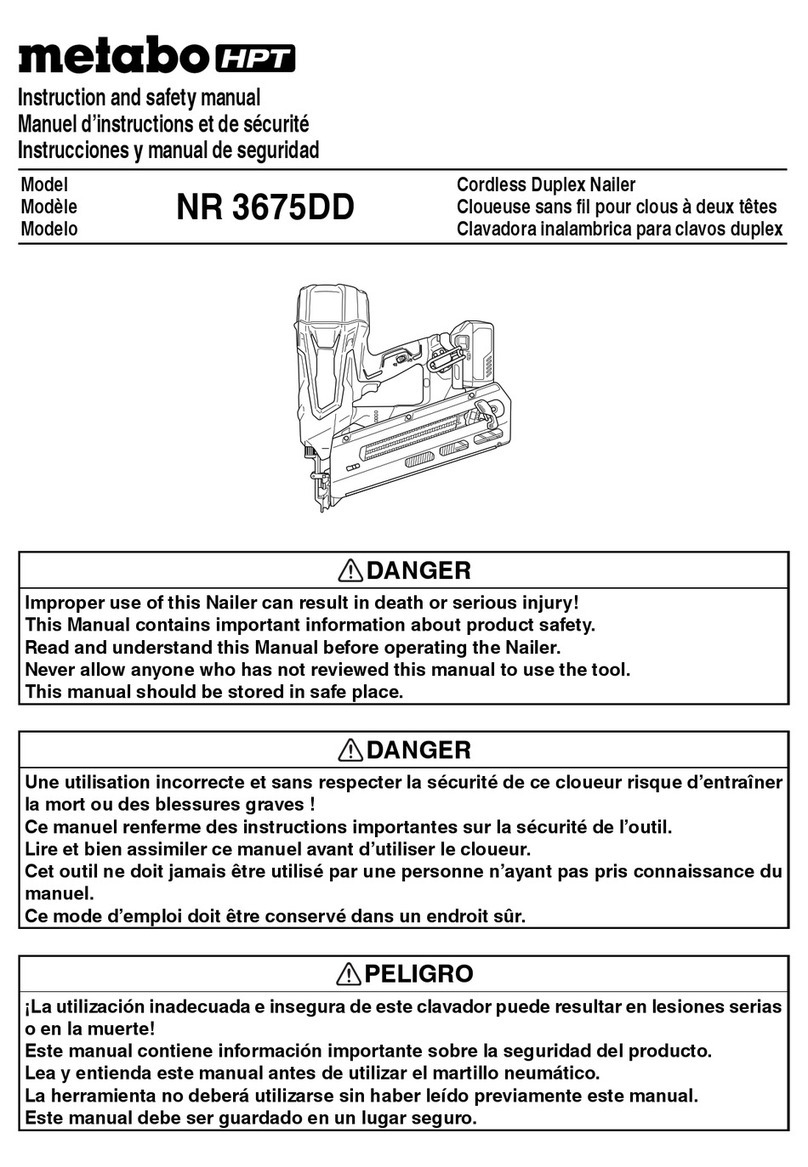
Metabo HPT
Metabo HPT NR 3675DD Instruction and safety manual
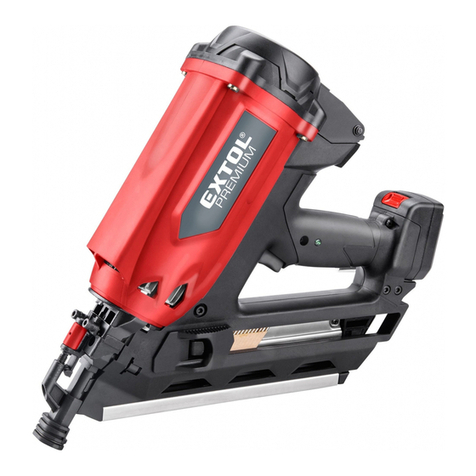
EXTOL PREMIUM
EXTOL PREMIUM 8894580 Translation of the original user manual
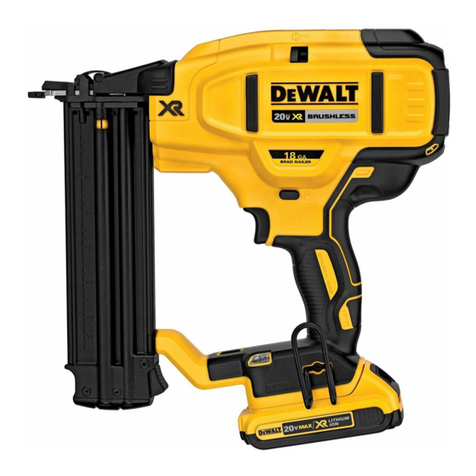
DeWalt
DeWalt XR Li-Ion DCN680D2 Original instructions
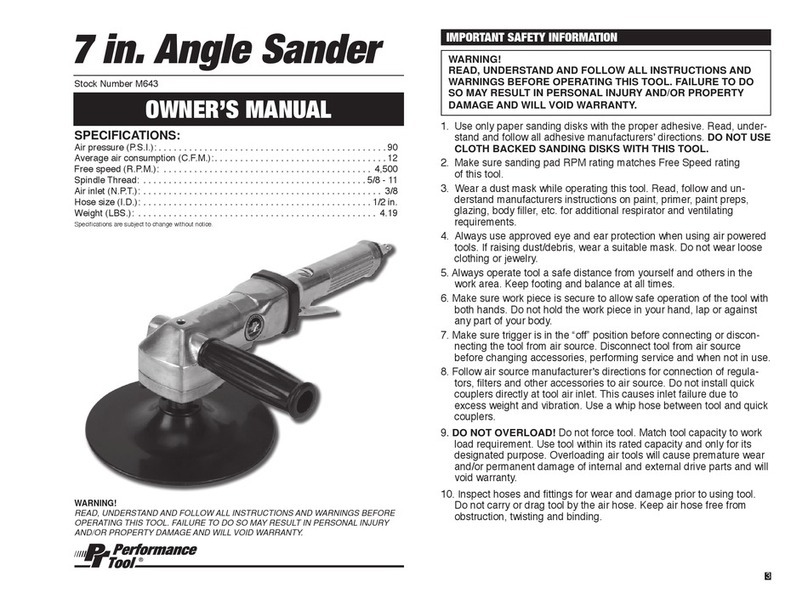
Performance Tool
Performance Tool M643 owner's manual
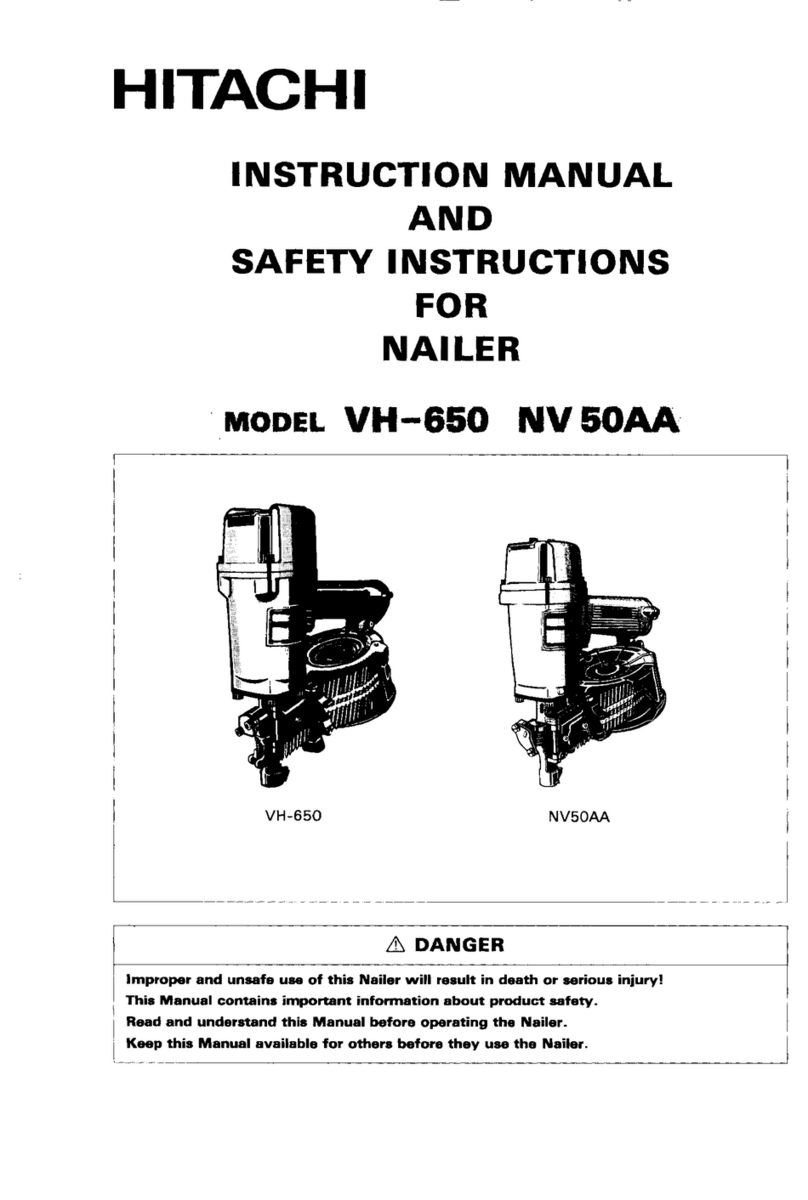
Hitachi
Hitachi VH650 - Fencing Nailer, Full Head instruction manual

Parkside
Parkside PET 25 B1 Operation and safety notes
